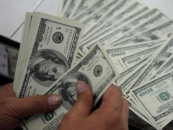Trade deficit shrinks $2.1b but exports fail to pick up pace
Adviser says exports are not gaining momentum due to lag effect of rupee depreciation

Adviser says exports are not gaining momentum due to lag effect of rupee depreciation. PHOTO: FILE
The trade deficit, which stood at $21.3 billion in July-January FY18, contracted 9.7% to $19.3 billion in the corresponding period of current fiscal year, according to the Pakistan Bureau of Statistics (PBS). In absolute terms, there was a decline of $2.1 billion in the deficit, which was a huge relief for the government.
Imports during the July-January FY19 period dropped 5.2% or $1.8 billion to $32.5 billion. However, the pace of increase in exports did not match the facilitation measures that the Pakistan Muslim League-Nawaz (PML-N) as well as the Pakistan Tehreek-e-Insaf (PTI) governments had taken since 2016.
Exports in first seven months of FY19 amounted to only $13.2 billion, up 2.24% or $290 million.
This came despite the fact that the central bank, in consultation with the finance ministry, let the currency depreciate 32.7% since December 2017. The rupee has weakened over 15% since the start of current fiscal year in July 2018.
The PML-N government doled out a Rs180-billion package to the exporters. The PTI administration has also offered an incentive package of over Rs30 billion in the shape of lower gas and electricity prices for export-focused industries. Exports were not picking up momentum due to the lag effect of currency devaluation, remarked Adviser to Prime Minister on Commerce and Investment Abdul Razak Dawood.
He voiced hope that exports would gain pace in the next couple of months once all the policy and administrative measures were fully in place. Dawood said because of the trade war between the US and China, US buyers were shifting towards Vietnam, Bangladesh and Pakistan, which would give a boost to Pakistan’s exports.
Pakistan had closed the last fiscal year with a trade deficit of $37.6 billion, which became the key reason behind the highest-ever current account deficit of $18.9 billion. The PTI government wants to cut the trade deficit to about $26 billion, which seems highly unlikely now.
The value of exported goods was 245% less than the value of imports - a ratio that was slightly better than the previous month.
The trade balance in January 2019 compared to January last year significantly improved, again primarily because of contraction in imports. The trade deficit shrank 31.7% to $2.5 billion in January this year. In absolute terms, there was a reduction of $1.1 billion in the deficit.
Trade deficit shrinks 5% to $16.8b as imports go down
On a month-on-month basis, the exports contracted 1.8% in January over the preceding month. Exports decreased $37 million to $2 billion. Imports, however, rose 1.4% to $4.5 billion in January. Resultantly, the trade deficit widened 4.1% to $2.5 billion in January over December.
Exports rise 30% in rupee terms
Speaking at a press conference on Monday, Dawood said the trade deficit had been brought down by $2 billion in first seven months of the current financial year as runaway imports had been squeezed.
“We are hopeful that the deficit will go down by $4-5 billion by the end of current financial year,” he said.
Trade volume between Pakistan, Sri Lanka surges after FTA
Exports increased 4% in dollar terms in January 2019 compared to the corresponding month of previous year. However, he said, the increase in exports was 30% in rupee terms due to depreciation of the rupee. In January 2019, imports came down 19% in dollars terms and 31.7% in rupee terms, the adviser said.
He pointed out that the government had imposed regulatory duty on non-essential goods and imposed ban on furnace oil imports. “Imports were higher last year due to the import of machinery for power plants; the government’s policy of squeezing imports is yielding results,” he stressed.
The PM adviser said domestic sale of cement had dropped 9% but its exports rose 50%, reaching $180 million in Jul-Jan FY19. Cement was mainly exported to Bangladesh and Sri Lanka. He pointed out that Pakistan was importing edible oil of over $3 billion per annum and the government wanted to curtail it by focusing on sunflower and canola crops in the country.
The adviser, however, emphasised that he was not satisfied with the current volume of exports, adding that textile units had the capacity to enhance shipments to overseas markets. Speaking on the occasion, Commerce Secretary Younus Dagha revealed that the government was focusing on exploring markets of African countries and would open trade offices in big countries of the continent with higher economic growth.
Published in The Express Tribune, February 12th, 2019.
Like Business on Facebook, follow @TribuneBiz on Twitter to stay informed and join in the conversation.



















COMMENTS
Comments are moderated and generally will be posted if they are on-topic and not abusive.
For more information, please see our Comments FAQ